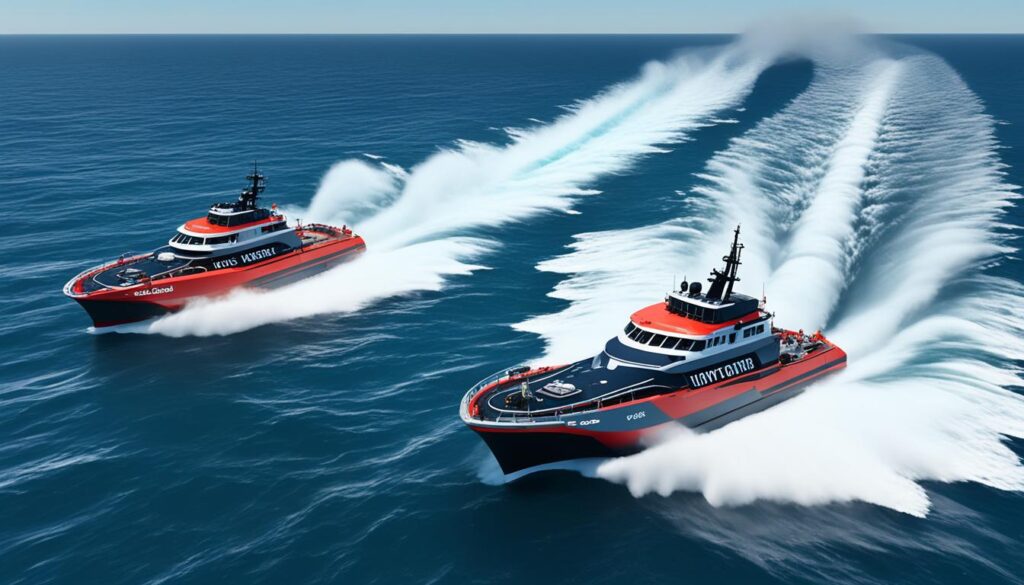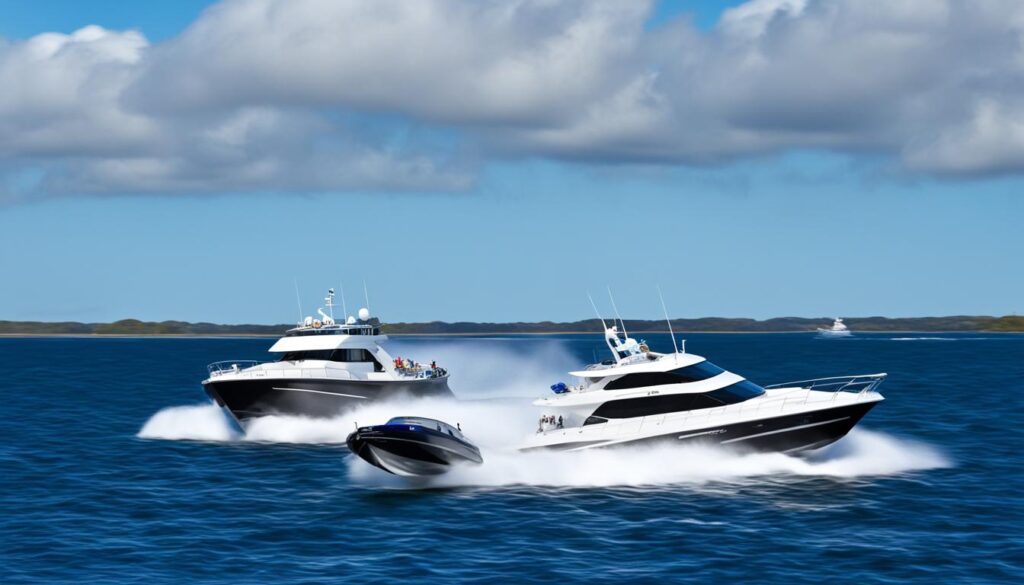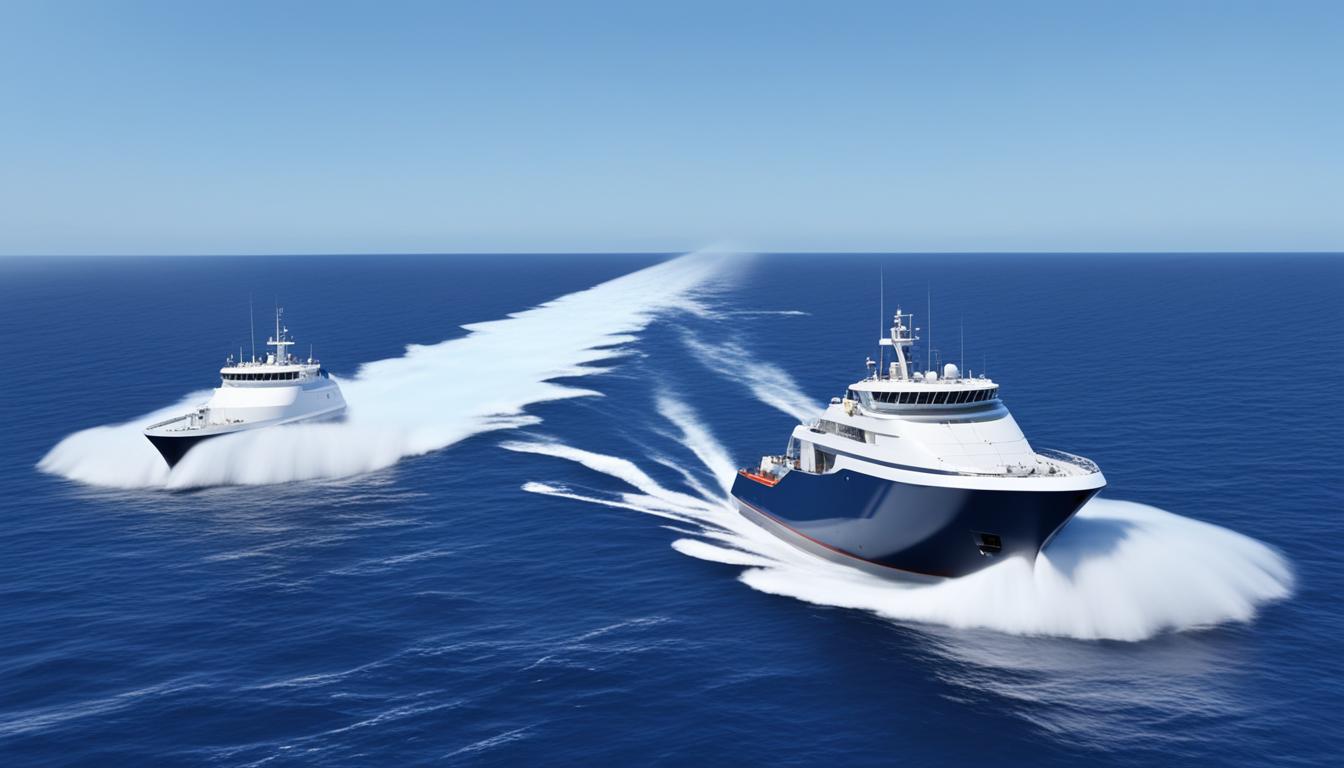When two powered vessels approach each other in a head-on situation, it is crucial for both operators to take necessary actions to ensure a safe passing arrangement and prevent collisions. Altering their course to starboard (right) and passing each other port (left) side to port (left) side is the recommended maneuver in this scenario. By following this protocol, vessel operators can reduce the risk of accidents and navigate the waters responsibly.
In addition to altering course, maintaining a safe speed is essential to facilitate a smooth and uneventful passage. Both operators must also keep a vigilant lookout for other vessels in the vicinity and be prepared to adjust their course if necessary. Clear communication and adherence to navigational rules further contribute to a safe and harmonious passage in such encounters.
Key Takeaways:
- When two powered vessels approach each other in a head-on situation, operators should alter their course to starboard and pass port side to port side.
- Maintain a safe speed and always keep a vigilant lookout for other vessels.
- Clear communication and adherence to navigational rules are crucial for a safe passage.
Responsibility for Avoiding Collisions
In a situation where two boats are operating in the same general area, both operators have a shared responsibility for avoiding a collision. It is crucial for vessel operators to prioritize safety and take proactive measures to prevent accidents on the water. Adhering to navigational rules and maintaining a proper lookout are essential components of responsible boating.
When vessels approach each other, determining the right-of-way is crucial for establishing a smooth and safe passage. Factors such as the type of vessels involved – power-driven or sailing – and the specific approach – meeting head-on, crossing paths, or overtaking – help determine which vessel has the right-of-way. Abiding by these rules ensures a clear understanding of responsibility and minimizes the risk of collision.
Both vessel operators must remain alert and vigilant at all times, constantly scanning the area for other boats and potential hazards. This includes monitoring the movement of nearby vessels and predicting their intentions to anticipate any potential conflicts. By doing so, operators can take necessary actions promptly to prevent a collision and maintain a safe distance from other vessels.
“Boat operators must remember that the responsibility for avoiding collisions falls on each individual. It is not enough to rely solely on others to maneuver out of the way. Every operator must actively contribute to safe navigation.” – Michael Anderson, Australian Boating Safety Authority
Communication plays a vital role in collision avoidance. Effective communication between operators enhances situational awareness and coordination, allowing both parties to make informed decisions. This includes using visual signals, sound signals, and radio communication to convey intentions and establish a clear passage plan. Mutual cooperation and understanding are essential for a safe and smooth navigation experience.
Ultimately, vessel operators must uphold their responsibility for avoiding collisions by adhering to navigational rules, maintaining a proper lookout, and taking necessary actions promptly. By prioritizing safety and practicing responsible boating, operators ensure a secure environment for themselves and other waterway users.
Head-On Encounter and Stand-On Vessel
In a head-on encounter between a motorboat and a personal watercraft (PWC), the stand-on vessel is typically the motorboat. The motorboat should maintain its course and speed unless it becomes apparent that the PWC is not taking appropriate action. Communication between the operators is essential to ensure a safe passage.
When faced with a head-on encounter, the operators of both the motorboat and the PWC must exercise caution and be aware of their responsibilities. The motorboat, as the stand-on vessel, has the right-of-way in such a situation. It should continue on its current course and maintain its speed, while closely monitoring the actions of the PWC.
Communication and clear signaling are vital during a head-on encounter. The motorboat operator should maintain a watchful eye on the PWC and be prepared to take evasive action if necessary. In the event that the PWC fails to change course or behaves in a manner that compromises the safety of both vessels, the motorboat operator may need to alter their course to avoid a collision.
It is important to note that the operator of the PWC should also be attentive to the situation and adhere to the provisions of maritime rules and regulations. The PWC operator should actively monitor the motorboat’s actions and respond accordingly to avoid any potential collision.

By maintaining good situational awareness and communicating effectively, both the motorboat and PWC operators can navigate a head-on encounter safely and avoid any potential accidents.
Overtaking and Give-Way
When one boat is overtaking another, it is important for both boat operators to understand their roles and responsibilities to ensure a safe and smooth passage. In this scenario, the boat being overtaken is generally considered the stand-on vessel, while the boat overtaking is the give-way vessel.
The stand-on vessel, or the boat being overtaken, should maintain its course and speed unless instructed otherwise by maritime rules or the give-way vessel. It is crucial to keep a vigilant lookout and be aware of the approaching vessel’s intentions.
The give-way vessel, or the boat overtaking, must maneuver in a way that ensures a safe and clear passage, keeping a safe distance from the boat being overtaken. It is the responsibility of the give-way vessel to assess the situation and execute the overtaking maneuver safely and responsibly.
In order to avoid any potential collisions, the give-way vessel should:
- Ensure there is enough space and time to overtake without endangering the stand-on vessel.
- Clearly communicate intentions to the stand-on vessel using appropriate navigational signals or radio communication.
- Pass the stand-on vessel on the side agreed upon, maintaining a safe distance throughout the maneuver.
- Return to the original course and speed once the overtaking maneuver is completed and it is safe to do so.
By following these guidelines, boat operators can effectively manage overtaking situations and minimize the risk of accidents or collisions.
Example of Overtaking and Give-Way Responsibilities:
Operator A is piloting a motorboat and wishes to overtake Operator B’s sailboat. Operator A must carefully assess the situation, considering factors like the speed and distance between the two vessels. Once determined safe, Operator A should inform Operator B of the intention to overtake using standard visual or auditory signals.
Operator B, the stand-on vessel, will maintain its course and speed, and may alter it slightly to facilitate the overtaking maneuver. Operator B will monitor Operator A’s movements closely to ensure their safety and cooperate by maintaining a predictable course.
Once the overtaking maneuver is completed, Operator A should communicate their return to the original course and speed to Operator B, ensuring a clear understanding between both operators to prevent any further confusion or potential hazards.
Summary of Overtaking and Give-Way Guidelines:
| Overtaking Vessel: | Give-Way or Stand-On Vessel: |
|---|---|
| Maintain a safe distance. | Maintain course and speed. |
| Communicate intentions. | Be aware of approaching vessel. |
| Pass on agreed side. | Cooperate and maintain predictability. |
| Return to original course and speed. | Ensure a clear understanding. |

When it comes to navigating the waters and ensuring the safety of all on board, collision avoidance is a shared responsibility among boat operators. Both operators have a crucial role to play in preventing collisions and maintaining a safe environment for themselves and others. By following navigational rules and adopting best practices, operators can minimize the risk of accidents and promote a culture of safety.
First and foremost, maintaining a proper lookout is essential. Boat operators must remain vigilant, keeping their eyes on the surrounding environment at all times. This includes being aware of other vessels in the vicinity, navigational aids, and potential hazards. By being attentive, operators can anticipate potential collision risks and take appropriate action to avoid them.
Adhering to navigational rules is another key aspect of collision avoidance. Boat operators must familiarize themselves with and follow the rules and regulations set forth by maritime authorities. These rules provide guidelines for right-of-way, speed restrictions, and other important considerations when operating a vessel. By abiding by these rules, boat operators can navigate safely and reduce the likelihood of collisions.
Clear communication among boat operators is also crucial for collision avoidance. Operators should establish effective means of communication, whether it’s through the use of marine radios, visual signals, or other approved methods. By clearly communicating their intentions and responding to the signals of other vessels, operators can coordinate their movements and ensure a safe passage for all.
“Clear communication and mutual understanding between operators are essential in ensuring collision avoidance.”
Maintaining a safe speed is equally important in collision avoidance. Boat operators should operate their vessels at safe speeds that allow for proper maneuverability and response to changing situations. Speeding can greatly reduce the time available for operators to react and take evasive action, leading to a higher risk of collisions. By maintaining a safe speed, operators can enhance their ability to avoid potential accidents.
Ultimately, collision avoidance is a shared responsibility that should be prioritized by all boat operators. By maintaining a proper lookout, following navigational rules, communicating effectively, and maintaining safe speeds, operators can greatly reduce the risk of collisions and ensure the safety of themselves and others on the water.
The shared responsibility for collision avoidance among boat operators offers several benefits:
- Promotes a culture of safety on the water.
- Reduces the risk of accidents and potential injuries.
- Enhances the overall boating experience for everyone.
- Minimizes damage to vessels and property.
- Instills confidence and trust in the boating community.
By embracing the concept of shared responsibility, boat operators can contribute to a safer boating environment and ensure enjoyable experiences for all who take to the water.
Tips for Effective Collision Avoidance
Here are some practical tips that boat operators can follow to enhance collision avoidance:
- Maintain a proper lookout at all times.
- Stay aware of other vessels and potential hazards.
- Learn and follow navigational rules and regulations.
- Use effective communication methods with other operators.
- Operate at safe speeds that allow for quick response.
- Take evasive action when necessary to avoid collisions.
By incorporating these tips into their boating practices, operators can improve collision avoidance skills and contribute to a safer and more enjoyable boating experience for all.
Conclusion
In conclusion, when two powered vessels approach each other in a head-on situation, vessel operators must prioritize safety protocols to prevent collisions. It is essential for both operators to alter their course to starboard and pass each other port side to port side, ensuring a safe passing arrangement. Maintaining a safe speed, clear communication, and vigilant lookout are also crucial aspects of collision avoidance.
Collisions at sea can have serious consequences, endangering the lives of those on board. Therefore, both vessel operators must take shared responsibility in adhering to safety protocols and following maritime regulations. By doing so, they contribute to ensuring the safety and well-being of everyone at sea.
By implementing these safety measures and promoting responsible behavior, vessel operators play a vital role in preventing accidents and maintaining a secure maritime environment. Remember, practicing safety protocols is not only a legal requirement but also a moral obligation to protect oneself and others. Let’s keep our waters safe by prioritizing safety and following proper procedures at all times.
